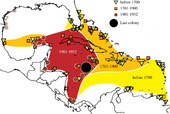Highlight
Extinction Rate, Historical Population Structure and Ecological Role of the Caribbean Monk Seal
Achievement/Results
IGERT Fellow, Loren McClenachan
Loren McClenachan and Andrew Cooper published a paper in the Proceedings of the Royal Society B, “Extinction rate, historical population structure and ecological role of the Caribbean monk seal.” This research found that the historical populations of the now-extinct Cairbbean monk seal (Monachus tropicalis) were widespread in the Caribbean Sea and that their extinction followed predictable geographic patterns over the last 300 years (Figure). This research is significant because it developed methods to rigorously analyze limited ecological data and crossed disciplines in the application of quantitative analyses and because the results have startling implications for the state of modern ecosystems and the recovery potential of related extant but endangered species.
Using historical and archaeological data, this study reconstructed the population size, distribution, and ecological role of this once common predator, and estimated the abundance of reef fish and invertebrates under more natural conditions. More than 200,000 monk seals consumed more fish and invertebrates than exist on any Caribbean reef today. These results provide temporal evidence that severe overfishing has occurred throughout coral reef foodwebs in the Caribbean and have implications for the recovery of other monk seal species. In particular, the closely related endangered Hawaiian monk seal may be limited by prey availability, which suggests that recovery plans must include efforts to reduce pressure on overexploited fish stocks utilized by these marine predators.
Research was conducted at the Scripps Institution of Oceanography by NSF funded graduate student (the project was not specifically funded by NSF), Loren McClenachan, who collaborated with Dr. Andrew Cooper at the University of New Hampshire.
Note: Loren McClenachan also contributed the chapter: Social Conflict, OverFishing and Disease in the Florida Sponge Fishery, 1849-1939 in the book Oceans Past: A Guide to Oceans Future. his insightful analysis is a story of change in both the human and ecological environments. It is a poignant example of how long-term environmental stress caused by over-fishing lowers biological and commercial productivity, increases the likelihood of punctuated disease events, and takes a harsh toll on people who make their living from the sea.
Address Goals
This research is significant because it developed methods to rigorously analyze limited ecological data and crossed disciplines in the application of quantitative analyses and because the results have startling implications for the state of modern ecosystems and the recovery potential of related extant but endangered species.







